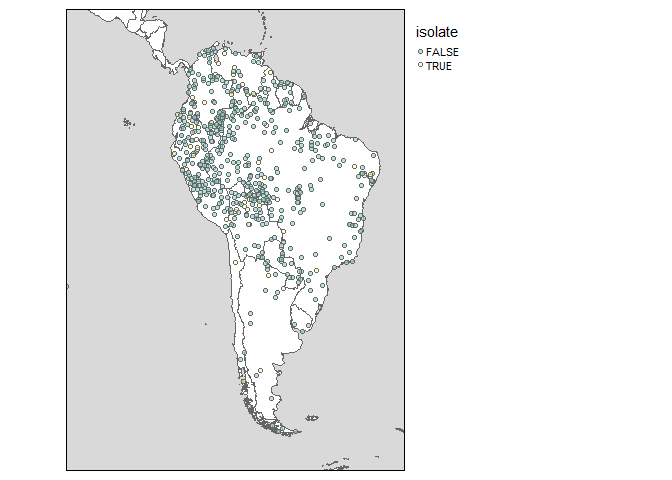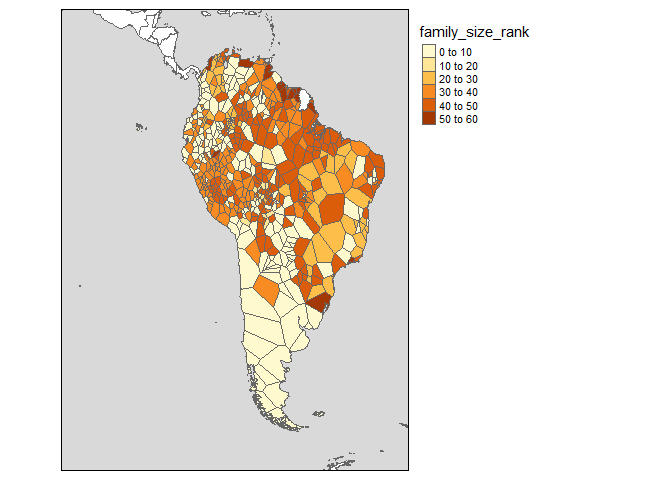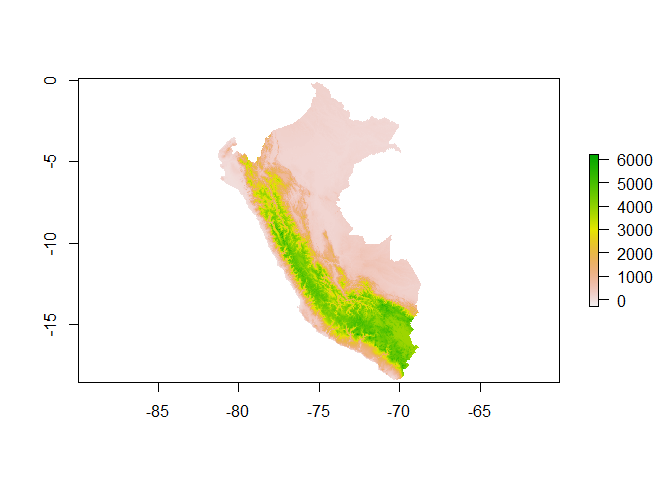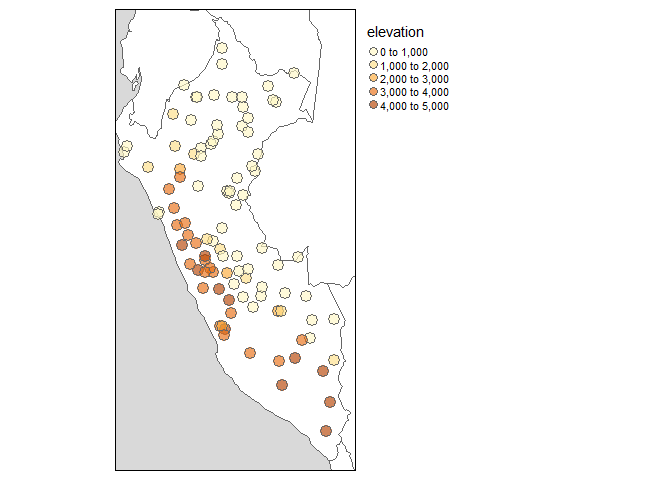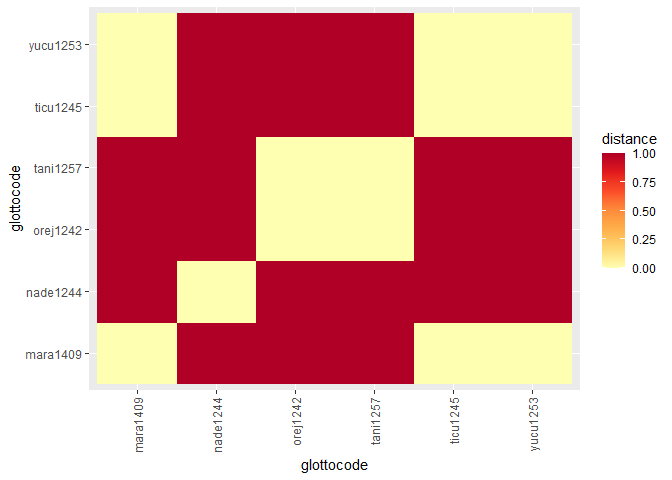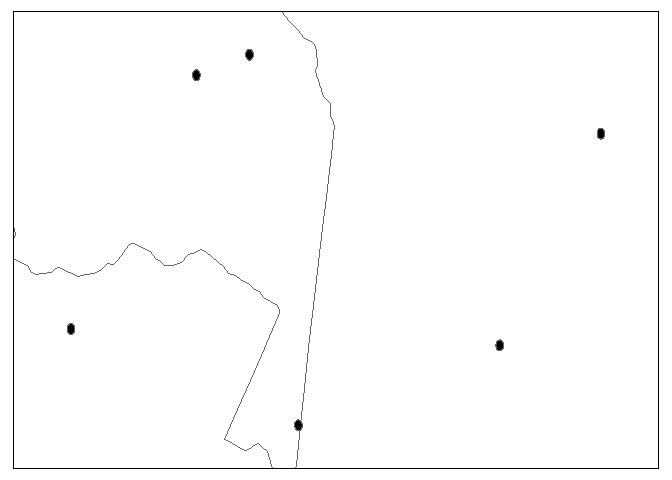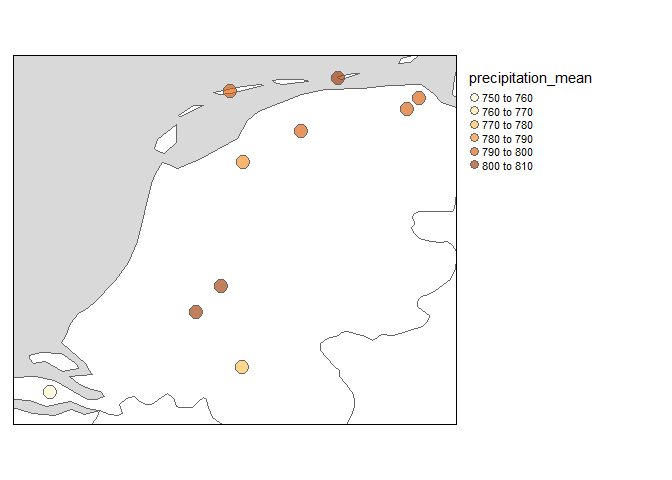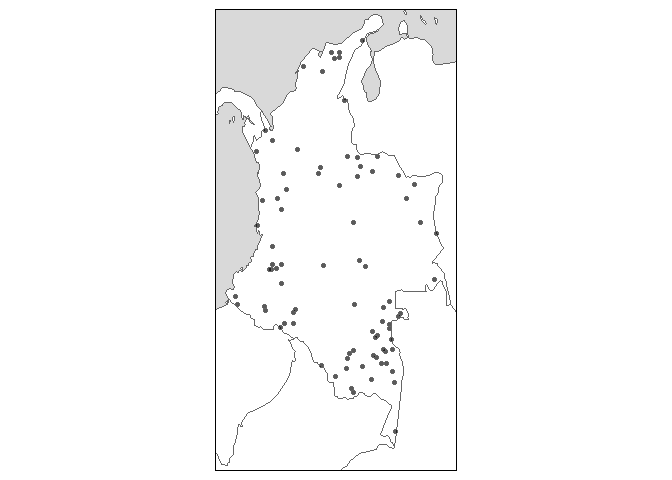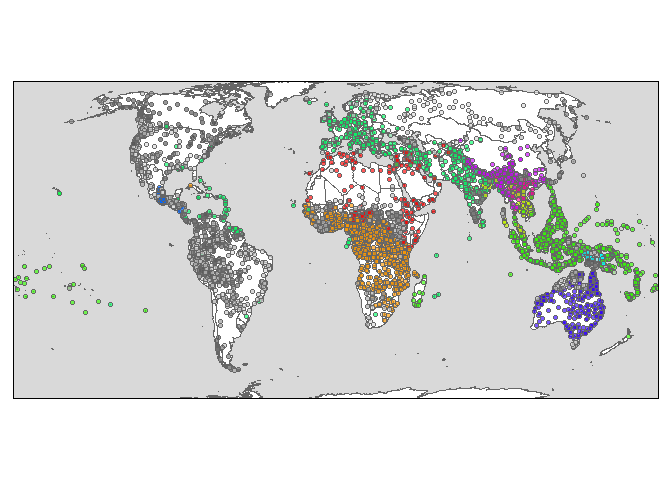glottospace: R package for the geospatial analysis of linguistic and cultural data.
Introduction
The glottospace package facilitates the geospatial analysis of linguistic and cultural data. It does so by using data from glottolog and enhancing it spatially using a combination of spatial packages. With glottospace you can join your own data with an enhanced version of glottolog and explore your data on a map. With glottospace you can calculate and visualise geographic distances and linguistic distances. The aim of glottospace is to provide a streamlined workflow for working with spatio-linguistic data: from data import, data cleaning, data exploration to visualisation and data export.
Development
This package is still under active development. While the basic functionality has been implemented, we’re still working on adding new functions and improving existing ones. While using glottospace you will certainly find bugs or encounter things you might find confusing. You can help me improve the package by:
- Sending an email to Sietze Norder with a clear description of the issue or error message.
- Opening a new issue in the glottospace issues page on GitHub
Citation
Once there is a stable version of the package we intend to write a paper about it presenting its full functionality. If you find the glottospace package useful, please cite it in your work:
#>
#> To cite glottospace in publications use:
#>
#> Norder, S.J. et al. (2021). glottospace: R package for the geospatial
#> analysis of linguistic and cultural data. URL
#> https://github.com/SietzeN/glottospace.
#>
#> A BibTeX entry for LaTeX users is
#>
#> @Article{,
#> title = {glottospace: R package for the geospatial analysis of linguistic and cultural data},
#> author = {{Norder} and S.J. et al.},
#> journal = {R package version 0.0.1},
#> year = {2021},
#> url = {https://github.com/SietzeN/glottospace},
#> }
The package builds on the glottolog database and uses several rspatial packages, of which sf, raster and tmap are the most important ones. Please cite those as well.
Installation
You can install the development version of glottospace from GitHub with:
# install.packages("devtools")
devtools::install_github("SietzeN/glottospace")Example
Before describing the functionality of glottospace, I give a quick demonstration of a typical workflow.
Plotting language locations on a map
Imagine you’re working with languages in a particular region, and want to visualize them on a map. With glottospace this is easy! You could for example filter all languages in South America, and show which ones of them are isolate languages:
library(glottospace)
## Plot point data:
glottomap(continent = "South America", color = "isolate")Languages are often represented with points, while in reality the speakers of a language can inhabit vast areas. Glottospace works with point and polygon data. When polygon data is not available, you can interpolate the points and plot those.
## Filter by continent
glottopoints <- glottofilter(continent = "South America")
# Interpolate points to polygons:
glottopols <- glottospace(glottopoints, method = "voronoi", continent = "South America")
# Plot polygon data:
glottomap(glottodata = glottopols, color = "family_size_rank")Adding contextual data for specific languages
Imagine you are interested in a particular set of languages, and want to add some contextual information.
# Search languages:
glottosearch(find = "chichom")[,c("name", "family_name")]
#> Simple feature collection with 6 features and 2 fields
#> Geometry type: POINT
#> Dimension: XY
#> Bounding box: xmin: -100.524 ymin: -5.30044 xmax: -77.2641 ymax: 21.2943
#> Geodetic CRS: WGS 84
#> name family_name geometry
#> 1269 Chicomuceltec Mayan POINT (-91.2869 15.6078)
#> 1270 Chichimeca-Jonaz Otomanguean POINT (-100.524 21.2943)
#> 37 Achuar-Shiwiar Chicham POINT (-77.2641 -2.82646)
#> 81 Aguaruna Chicham POINT (-77.9218 -5.30044)
#> 2388 Huambisa Chicham POINT (-77.9797 -3.99109)
#> 6072 Shuar Chicham POINT (-78.1892 -3.45136)There are 6 languages that resemble our search term, of which 4 belong to the Chicham language family. Let’s view one of them on glottolog:
glottocode_online("shua1257")Let’s see at which elevation Peruvian languages are spoken. First get and extract environmental data.
peruvians <- glottofilter(country = "Peru")
elevation <- geoget(geodata = "elevation", country = "Peru")
#> Warning in showSRID(uprojargs, format = "PROJ", multiline = "NO", prefer_proj
#> = prefer_proj): Discarded datum Unknown based on WGS84 ellipsoid in Proj4
#> definition
# Let's make a map:
geomap(elevation)# Extract elevation for each language
elevperuvians <- extractgeodata(glottodata = peruvians, geodata = elevation)
#> geodata extractedLet’s plot the elevation of the Peruvians:
glottomap(glottodata = elevperuvians, color = "elevation", ptsize = 0.85)Workflow of glottospace
The glottospace package offers a wide range of functions to work with spatio-linguistic data. The functions are organized into the following function families, of which the core function generally has the same name as the family to which it belongs:
-
glottoget: download glottodata from remote server, or load locally stored glottodata.
-
glottocreate: create empty glottodata structure, to add data manually.
-
glottocheck: run interactive quality checks of user-provided glottodata.
-
glottoclean: clean-up glottodata.
-
glottojoin: join user-provided glottodata with other (often online) datasets.
-
glottosearch: search glottolog database for languages, language families, glottocodes, etc.
-
glottofilter: filter/subset glottodata based on linguistic and geographic features/variables.
-
glottodist: calculate differences/similarities between languages based on their features (linguistic, cultural, environmental, geographic, etc.).
-
glottoplot: visualizing differences/similarities between languages.
-
glottospace: make glottodata spatial, add coordinates, add spatial points or polygons to languages.
-
geoget: download geographic data from online sources, or load user-provided geographic data.
-
geotools: extract environmental data and add those to glottodata.
-
geodist: calculate geographic distances between languages.
-
glottomap: visualize linguistic and cultural data on a map.
-
glottosave: save output generated by glottospace (data, figures, maps, etc.).
glottoget
You can load locally stored glottodata (for example from an excel file or shapefile). The glottospace package has two built-in artificial demo datasets (“demodata” and “demosubdata”).
glottodata <- glottoget("demodata")
head(glottodata)
#> glottocode var001 var002 var003
#> 1 yucu1253 Y a N
#> 2 tani1257 <NA> b Y
#> 3 ticu1245 Y a Y
#> 4 orej1242 N b N
#> 5 nade1244 N c Y
#> 6 mara1409 N a NYou can also load glottodata from online databases such as glottolog. You can download a raw version of the data (‘glottolog’), or an enriched/boosted version (‘glottobase’):
# Two ways to load glottobase:
data("glottobase")
glottobase <- glottoget("glottobase")
colnames(glottobase)
#> [1] "glottocode" "family_id" "parent_id"
#> [4] "name" "isocode" "child_dialect_count"
#> [7] "country_ids" "family_name" "isolate"
#> [10] "family_size" "family_size_rank" "country"
#> [13] "continent" "region" "geometry"glottocreate
You can generate empty data structures that help you to add your own data in a structured way. These data structures can be saved to your local folder by specifying a filename (not demonstrated here).
glottocreate_data(glottocodes = c("yucu1253", "tani1257"), variables = 3, meta = FALSE)
#> glottocode var001 var002 var003
#> 1 yucu1253 NA NA NA
#> 2 tani1257 NA NA NAI’ve specified meta = FALSE, to indicate that we want to generate a ‘flat’ glottodata table. However, when creating glottodata, by default, several meta tables are included:
glottodata_meta <- glottocreate_data(glottocodes = c("yucu1253", "tani1257"), variables = 3)
summary(glottodata_meta)
#> Length Class Mode
#> glottodata 4 data.frame list
#> structure 6 data.frame list
#> metadata 6 data.frame list
#> references 7 data.frame list
#> readme 2 data.frame list
#> lookup 2 data.frame listThe majority of these metatables are added for the convenience of the user. The ‘structure’ table is the only one that is required for some of the functions in the glottospace package. A structure table can also be added later:
glottocreate_structuretable(glottocodes = c("yucu1253", "tani1257"),
varnames = c("var001", "var002", "var003"))
#> varname type levels weight groups subgroups
#> 1 var001 NA NA 1 NA NA
#> 2 var002 NA NA 1 NA NA
#> 3 var003 NA NA 1 NA NAMore complex glottodata structures can also be generated. For example, in cases where you want to distinguish between groups within each language.
# Instead of creating a single table for all languages, you might want to create a list of tables (one table for each language)
glottocreate_subdata(glottocodes = c("yucu1253", "tani1257"),
variables = 3, groups = c("a", "b"), n = 2, meta = FALSE)
#> $yucu1253
#> glottosubcode var001 var002 var003
#> 1 yucu1253_a_0001 NA NA NA
#> 2 yucu1253_a_0002 NA NA NA
#> 3 yucu1253_b_0001 NA NA NA
#> 4 yucu1253_b_0002 NA NA NA
#>
#> $tani1257
#> glottosubcode var001 var002 var003
#> 1 tani1257_a_0001 NA NA NA
#> 2 tani1257_a_0002 NA NA NA
#> 3 tani1257_b_0001 NA NA NA
#> 4 tani1257_b_0002 NA NA NAglottocheck
If you have your own data, you might want to do some interactive quality checks:
glottodata <- glottoget("demodata")
glottocheck(glottodata, diagnostic = FALSE)
#> No missing IDs
#> No duplicate IDs.
#> All variables have two or more levels (excluding NA)
#> All IDs are valid glottocodes
#> Some columns have missing data.
#> Some rows have missing data.I’ve now specified diagnostic = FALSE, but the default is to show some more extensive diagnostics (like a data coverage plot).
You can also check the metadata:
glottodata <- glottoget(glottodata = "demodata", meta = TRUE)
glottocheck_metadata(glottodata)
#> This glottodataset contains the folowing tables: glottodata, structure, metadata, references, readme, lookup
#> All types recognized
#> All weights are specifiedglottoclean
Once you’ve loaded glottodata, you might encounter some inconsistencies. For example, data-contributors might not have used a standardized way of coding missing values.
glottodata <- glottoget(glottodata = "demodata", meta = TRUE)
glottodata$structure
#> varname type levels weight groups subgroups
#> 1 var001 symm NA 1 NA NA
#> 2 var002 factor NA 1 NA NA
#> 3 var003 symm NA 1 NA NA
# glottodata <- glottoclean(glottodata)glottojoin
Join user-provided glottodata with other datasets, or with online databases.
# Join with glottospace
glottodata <- glottoget("demodata")
glottodatabase <- glottojoin(glottodata, with = "glottobase")
glottodataspace <- glottojoin(glottodata, with = "glottospace")
# Join with a dist object
dist <- geodist(glottodataspace)
glottodatadist <- glottojoin(glottodata, with = dist)
# Join a list of glottodata tables into a single table
glottodatalist <- glottocreate_subdata(glottocodes = c("yucu1253", "tani1257"),
variables = 3, groups = c("a", "b"), n = 2, meta = FALSE)
glottodatatable <- glottojoin(glottodata = glottodatalist)glottosearch
As demonstrated in the example above, you can search glottodata for a specific search term
You can search for a match in all columns:
glottosearch(find = "yurakar")[,"name"]
#> Simple feature collection with 1 feature and 1 field
#> Geometry type: POINT
#> Dimension: XY
#> Bounding box: xmin: -65.1224 ymin: -16.7479 xmax: -65.1224 ymax: -16.7479
#> Geodetic CRS: WGS 84
#> name geometry
#> 7701 Yuracaré POINT (-65.1224 -16.7479)Or limit the search to specific columns:
glottosearch(find = "Yucuni", columns = c("name", "family_name"))[,"name"]
#> Simple feature collection with 2 features and 1 field
#> Geometry type: POINT
#> Dimension: XY
#> Bounding box: xmin: -97.91818 ymin: -0.76075 xmax: -71.0033 ymax: 17.23743
#> Geodetic CRS: WGS 84
#> name geometry
#> 7687 Yucuna POINT (-71.0033 -0.76075)
#> 7688 Yucunicoco Mixtec POINT (-97.91818 17.23743)Sometimes you don’t find a match:
glottosearch(find = "matsigenka")[,"name"]
#> Simple feature collection with 0 features and 1 field
#> Bounding box: xmin: NA ymin: NA xmax: NA ymax: NA
#> Geodetic CRS: WGS 84
#> [1] name geometry
#> <0 rows> (or 0-length row.names)If you can’t find what you’re looking for, you can increase the tolerance:
glottosearch(find = "matsigenka", tolerance = 0.2)[,"name"]
#> Simple feature collection with 1 feature and 1 field
#> Geometry type: POINT
#> Dimension: XY
#> Bounding box: xmin: -74.4371 ymin: -11.5349 xmax: -74.4371 ymax: -11.5349
#> Geodetic CRS: WGS 84
#> name geometry
#> 4862 Nomatsiguenga POINT (-74.4371 -11.5349)Aha! There it is: ‘Machiguenga’
glottosearch(find = "matsigenka", tolerance = 0.4)[,"name"]
#> Simple feature collection with 12 features and 1 field
#> Geometry type: POINT
#> Dimension: XY
#> Bounding box: xmin: -74.4371 ymin: -14.9959 xmax: 166.738 ymax: 13.5677
#> Geodetic CRS: WGS 84
#> First 10 features:
#> name geometry
#> 1735 Eastern Maninkakan POINT (-10.5394 9.33048)
#> 3121 Kita Maninkakan POINT (-9.49151 13.1798)
#> 3205 Konyanka Maninka POINT (-8.89972 8.04788)
#> 3791 Maasina Fulfulde POINT (-3.64763 11.1324)
#> 3808 Machiguenga POINT (-72.5017 -12.1291)
#> 3964 Mandinka POINT (-15.65395 12.81652)
#> 4000 Mansoanka POINT (-15.9202 12.8218)
#> 4106 Matigsalug Manobo POINT (125.16 7.72124)
#> 4862 Nomatsiguenga POINT (-74.4371 -11.5349)
#> 5462 Piamatsina POINT (166.738 -14.9959)glottofilter
filter, select, query
eurasia <- glottofilter(continent = c("Europe", "Asia"))
wari <- glottofilter(glottodata = glottodata, glottocode = "wari1268")
indo_european <- glottofilter(glottodata = glottodata, family_name = 'Indo-European')
south_america <- glottofilter(glottodata = glottodata, continent = "South America")
colovenz <- glottofilter(country = c("Colombia", "Venezuela"))
# arawtuca <- glottofilter(glottodata = glottodata, expression = family_name %in% c("Arawakan", "Tucanoan"))glottodist
Quantify differences and similarities between languages glottodistances: calculating similarities between languages based on linguistic/cultural features
# In order to be able to calculate linguistic distances a structure table is required, that's why I specify meta = TRUE.
glottodata <- glottoget("demodata", meta = TRUE)
glottodist <- glottodist(glottodata = glottodata)
#> Warning in cluster::daisy(x = glottodata, metric = "gower", type = list(symm =
#> symm, : at least one binary variable has not 2 different levels.
#> Warning in min(x): no non-missing arguments to min; returning Inf
#> Warning in max(x): no non-missing arguments to max; returning -Inf
#> Warning in min(x): no non-missing arguments to min; returning Inf
#> Warning in max(x): no non-missing arguments to max; returning -Inf
# As we've seen above, in case you have glottodata without a structure table, you can add it:
glottodata <- glottoget("demodata", meta = FALSE)
structure <- glottocreate_structuretable()
glottodata <- glottodata_addtable(glottodata, structure, name = "structure")glottoplot
Visualizing differences (distances) between languages based on linguistic, cultural, and environmental features.
glottodata <- glottoget("demodata", meta = TRUE)
glottodist <- glottodist(glottodata = glottodata)
#> Warning in cluster::daisy(x = glottodata, metric = "gower", type = list(symm =
#> symm, : at least one binary variable has not 2 different levels.
#> Warning in min(x): no non-missing arguments to min; returning Inf
#> Warning in max(x): no non-missing arguments to max; returning -Inf
#> Warning in min(x): no non-missing arguments to min; returning Inf
#> Warning in max(x): no non-missing arguments to max; returning -Inf
glottoplot(glottodist)glottospace
This family of functions turns glottodata into a spatial object. As I’ve illustrated above, these can be either glottopoints or glottopols
glottodata <- glottoget("demodata")
glottospacedata <- glottospace(glottodata, method = "buffer", radius = 5)
#> Buffer created with a radius of 5 km.
# By default, the projection of maps is equal area, and shape is not preserved:
glottomap(glottospacedata)geoget
The geoget function supports both raster and vector formats. It either loads spatial data from a local path, or downloads is from a remote server.
climate <- geoget(geodata = "climate")[[12]]
names(climate) <- "precipitation"
geomap(climate)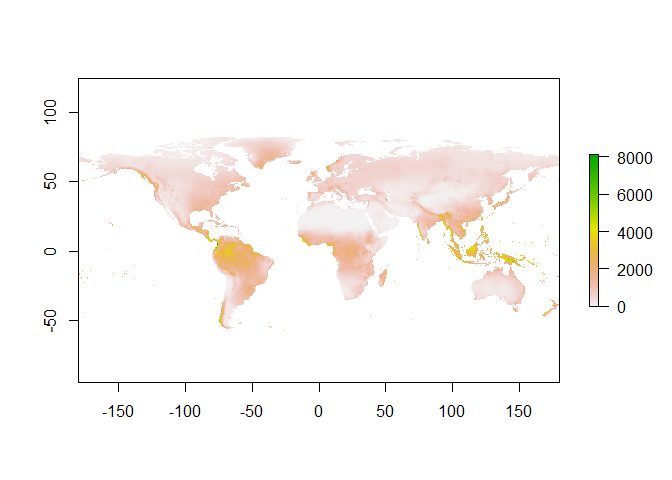 ## geotools
This is a large family of functions to work with spatial data. Most of
these however, will probably not be called directly by the users. I’ve
already demonstrated the function geodataextract() which can be used to
extract environmental data for languages. You can also use a buffer
radius to extract environmental features and summarize them. Here, I’m
using a buffer of 10 km and summarize by taking the mean.
## geotools
This is a large family of functions to work with spatial data. Most of
these however, will probably not be called directly by the users. I’ve
already demonstrated the function geodataextract() which can be used to
extract environmental data for languages. You can also use a buffer
radius to extract environmental features and summarize them. Here, I’m
using a buffer of 10 km and summarize by taking the mean.
dutchies <- glottofilter(country = "Netherlands")
climatedutchies <- extractgeodata(glottodata = dutchies, geodata = climate, radius = 10, fun = "mean")
#> Extracting values within a radius of 10 km.
#> geodata extracted
glottomap(climatedutchies, color = "precipitation_mean", ptsize = 1)geodist
geodistances: calculate distances between languages, nearest languages, etc.
glottodata <- glottoget("demodata")
glottodataspace <- glottospace(glottodata)
geodist(points = glottodataspace)
#> yucu1253 tani1257 ticu1245 orej1242 nade1244
#> tani1257 71
#> ticu1245 346 346
#> orej1242 286 345 304
#> nade1244 525 459 479 711
#> mara1409 461 417 272 553 237glottomap
With glottomap you can quickly visualize the location of languages. Below I show simple static maps, but you can also create dynamic maps by specifying type = “dynamic”.
You can pass arguments directly to glottofilter
glottomap(country = "Colombia")However, you can also create maps with other glottodata. For example, we might want to create a world map highlighting the largest language families
glottodata <- glottoget()
families <- glottodata %>% dplyr::count(family_name, sort = TRUE)
# highlight 10 largest families:
glottodata <- glottospotlight(glottodata = glottodata, spotcol = "family_name", spotlight = families$family_name[1:10], spotcontrast = "family_name", bgcontrast = "family_name")
# Create map
glottomap(glottodata, color = "color")glottosave
All output generated with the glottospace package (data, figures, maps, etc.) can be saved with a single command.
glottodata <- glottoget("demodata", meta = FALSE)
# Saves as .xlsx
glottosave(glottodata, filename = "glottodata")
#> Data.frame saved as glottodata.xlsx
glottospacedata <- glottospace(glottodata)
# Saves as .GPKG
glottosave(glottodata, filename = "glottodata")
#> Data.frame saved as glottodata.xlsx
glottomap <- glottomap(glottodata)
# By default, static maps are saved as .png, dynamic maps are saved as .html
glottosave(glottomap, filename = "glottomap")
#> Map saved to C:\Users\sjnor\surfdrive\PROJECTS_SN\SAPPHIRE\R\glottospace\glottomap.png
#> Resolution: 2510.749 by 1756.448 pixels
#> Size: 8.369165 by 5.854826 inches (300 dpi)
#> Map (tmap object) saved as glottomap.png
